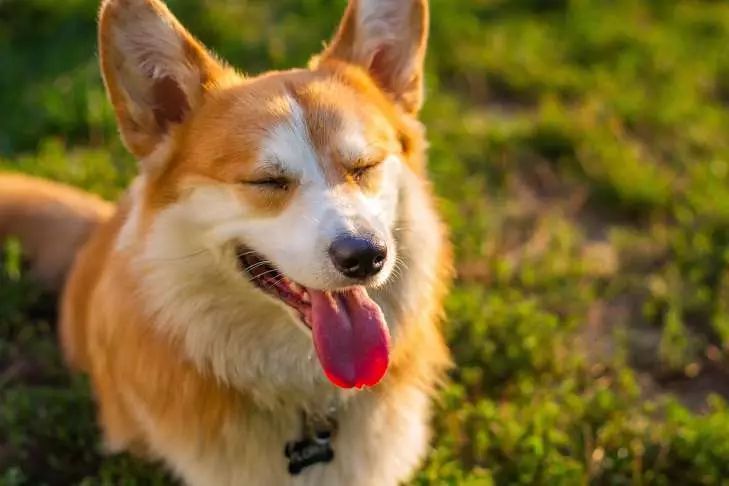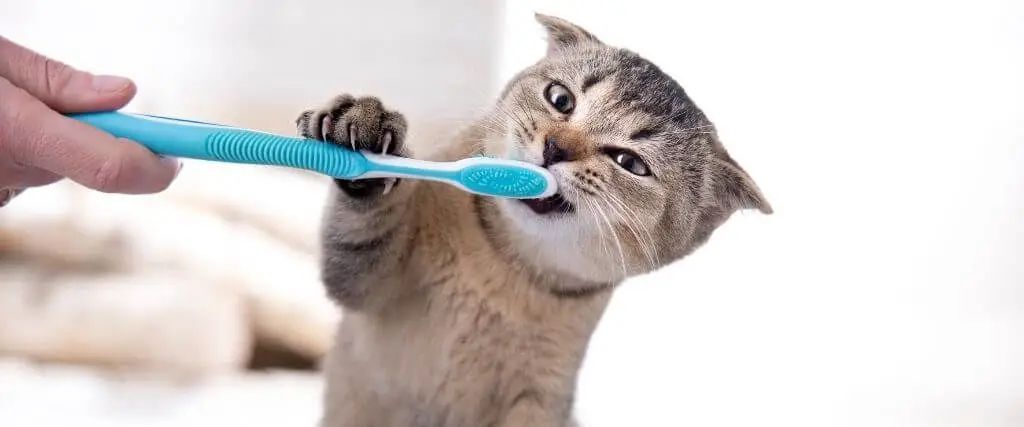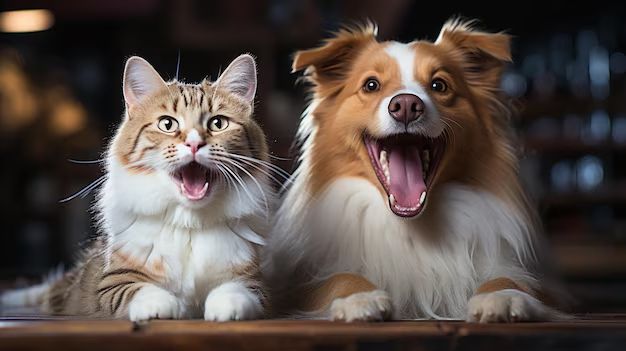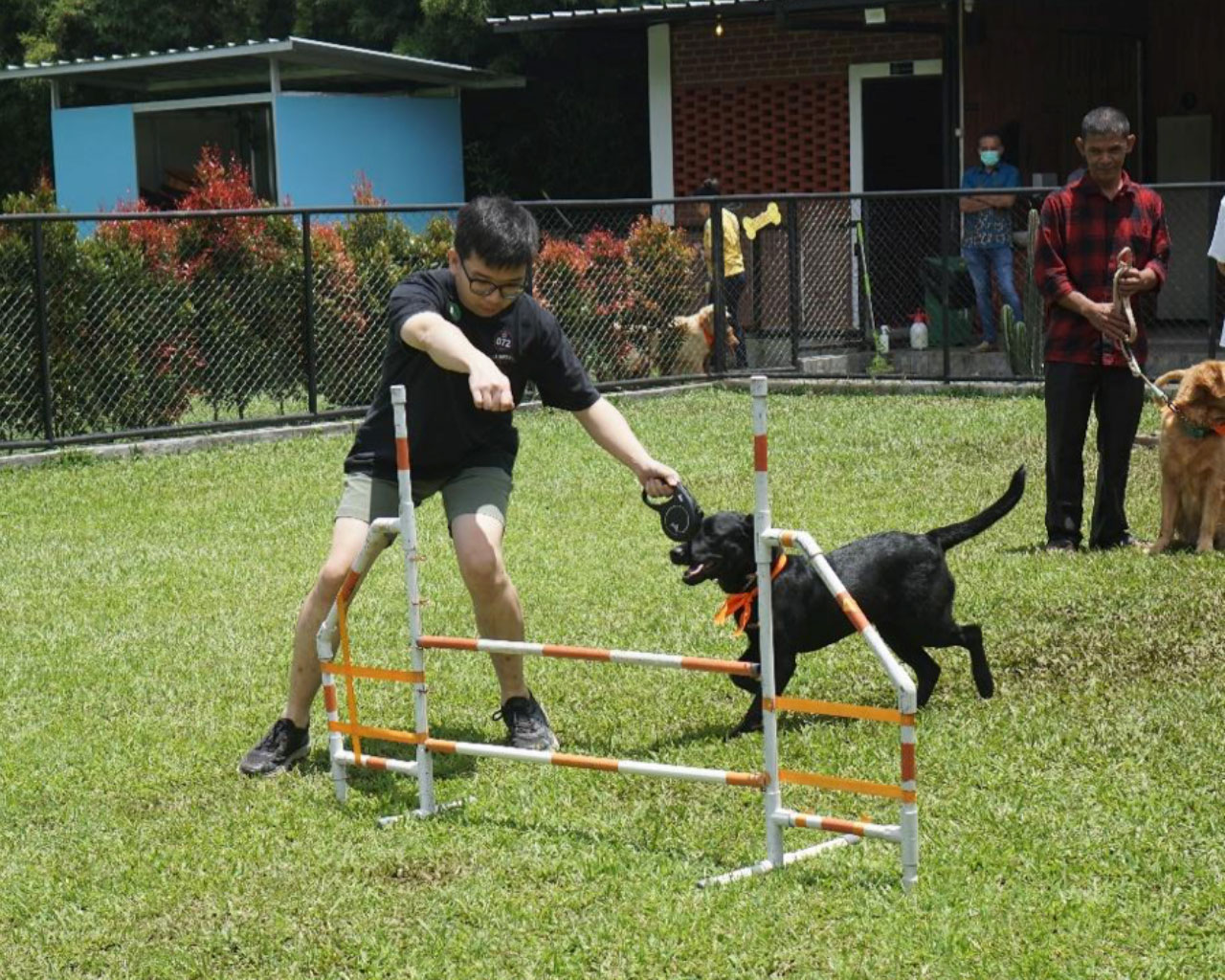Many pet parents overlook dental care — but your dog or cat’s mouth plays a huge role in their overall health. Gum disease doesn’t just lead to bad breath; it can cause pain, tooth loss, and even affect vital organs like the heart and kidneys if left untreated.
Just like humans, pets can develop plaque and tartar from leftover food particles. Over time, this buildup harbors bacteria that irritate the gums, leading to gingivitis and eventually periodontal disease. Sadly, most pets show signs of dental issues by age 3 — often without owners realizing it.
Cats may hide discomfort, but clues include drooling, pawing at the mouth, reduced grooming, or preferring soft food. Dogs may chew on one side, lose interest in hard treats, or show signs of bad breath. These are warning signs that your pet might be in pain or developing a serious issue.
The good news? Dental disease is preventable. Regular oral care can keep your pet smiling (and healthy) for years to come. Brushing, dental treats, and vet check-ups go a long way in keeping those teeth in top shape.
Tips for Maintaining Dental Health:
Brush your pet’s teeth 2–3 times a week with pet-safe toothpaste.
Provide dental chews or toys that help reduce tartar buildup.
Schedule a vet dental exam at least once a year.
Watch for changes in eating habits or signs of mouth pain.
Use water additives or oral rinses designed for pets as an extra boost.
Conclusion: Healthy Mouth, Happy Pet
Dental care isn't just a cosmetic concern — it's a key part of your pet’s overall wellness. With a few simple habits, you can prevent painful dental disease and give your furry friend a healthier, longer life.
Keep their teeth and gums in top shape with NatureBridge Classic Adult for Small Breed Dog and NatureBridge Classic Adult for Cat. Both variants feature ideal kibble sizes designed to help naturally clean teeth and massage gums while they chew. 🐾 Available now at our official store and pet shops across Indonesia — a tasty way to support oral health every day.
Dog owners might love to cuddle with their furry friends, but there’s little worse than being up close and personal with a dog’s mouth when they decide to yawn. All it takes is one whiff of stinky dog breath to ask yourself, “What could possibly be causing that smell?”.
No dog’s breath is going to be particularly pleasant—at least not by human standards. However, some breath ventures beyond the usual icky dog-food stench into something much worse. Extremely or unusually bad breath in dogs could actually be indicative of a health problem.
Where bad breath in dogs comes from
Most people assume that bad breath (also called halitosis) stems directly from the mouth. This is true in a lot of cases. Food particles and bacteria on the teeth and tongue are typically responsible for how your dog’s breath smells—whether it’s tolerable or one of the worst smells you’ve encountered.
However, not all bad breath in dogs is directly related to the mouth. Bacteria and acids that reside in the gut can also make their way up and cause malodorous breath. In this case, brushing your dog’s teeth isn’t likely to get rid of the stench. Instead, a more severe health problem might be at play.
Getting to the bottom of your pup’s stinky breath
Multiple things could be causing your dog’s breath to smell bad, ranging from perfectly harmless to hazardous to your pet’s health. You’ll need to consider your dog’s eating habits, potential symptoms and health routines in order to determine where the smell is really coming from.
Here are some of the most common culprits.
- Their food: Food is usually the first places pet parents look when their dog develops bad breath. This is a reasonable assumption, since food is formulated to taste and smell appealing to animals—not to us. After finishing off a meal, your dog’s breath might stink because of the food particles stuck on their teeth. Diet can also cause bad breath by disrupting the microbiome in your dog’s gut. When some bacteria grow unchecked, they can cause GI issues along with bad breath. It’s possible your dog’s food doesn’t agree with them, or might not be nutritionally balanced for their needs. However, if your dog’s bad breath develops suddenly without a change in diet, it’s unlikely that it’s related to their meals at all.
- Unsupervised eating: Another kind of food can also cause bad breath in dogs—the food they’re not supposed to eat! Dogs who like to rummage in the garbage, eat poop or attack small prey outdoors might experience a random bout of halitosis. Unsupervised snacking usually results in rotten-smelling breath.
- Oral health problems: If the problem isn’t your pet’s food, the next most likely cause is poor oral health. Plaque builds up on dogs’ teeth just like it does in humans, and this can cause bad breath. Over time, plaque hardens into tartar and can cause gum inflammation and disease. The more bacteria that accumulates on the teeth and gums, the worse the breath can get. Check your pup for red, swollen or bleeding gums and monitor their eating behavior for signs of tooth pain.
- Diabetes: Dogs with untreated diabetes might develop breath that smells sweet, fruity or like acetone. This change might not be that unpleasant, but it is important to pay attention to! The smell comes from the body producing ketones from metabolized fat. Other signs might include unexplained weight loss, increased thirst and changes in appetite.
- Liver disease: Liver disease in dogs is also known to cause bad breath. When the liver is damaged, it stops removing toxins and waste from your dog’s body. The disease typically leads to foul-smelling breath alongside symptoms like yellow gums or eyes, dark urine, weight loss and vomiting.
- Kidney disease: Kidney disease and failure can lead to bad breath, too. In this instance, your dog’s breath might smell like urine or ammonia. This is a result of the kidneys failing as your dog’s urinary filtration system. Watch for other signs like oral ulcers, vomiting and dehydration.
How to freshen your dog’s breath
At the first sign of bad doggy breath, owners might be tempted to toss their dog a dental treat and call it a day. However, treating halitosis relies on understanding exactly where the bad breath is coming from. By treating the underlying cause, you can freshen your pup’s breath in no time!
If you recently changed your dog’s food and suspect the bad breath is due to the flavor, give your dog a dental treat or brush their teeth after they eat to put a stop to the smell. You could also try a different type of food to see if the odor is more manageable. Keep your dog away from garbage they could eat and supervise them outside to make sure they don’t dig into any feces or roadkill.
It’s also smart to adopt an at-home oral care regimen. Get your dog used to daily tooth brushing, oral health supplements and dental toys or treats that keep their teeth squeaky clean. If your pet hasn’t had a professional cleaning in a while, it might be a good idea to check in with your vet and rule out gingivitis or dental disease.
After exploring food and dental care options, see if your dog’s breath improves. If it still smells bad—or if you pinpoint a sweet or ammonia smell—it’s time to visit the vet. They can run tests to see if your dog is experiencing diabetes or another disease and administer treatment right away.
Although it’s certainly unpleasant, bad breath in dogs is not something that should be ignored. If your dog suddenly develops stinky breath, take steps to determine the underlying cause and visit the vet if you have concerns about a major health problem. A single whiff could be the thing that saves your dog’s life!
Source: https://petwellbeing.com/
Keeping your cat’s teeth and gums healthy is important no matter how old they are. Unfortunately, our feline friends aren’t fond of having a toothbrush and gel used in their mouths. If your kitty refuses to let you brush their teeth, all hope isn’t lost for their oral health! There are a few other methods you can use to protect their teeth.
Here are a few of the best brushing alternatives to help your cat avoid problems like bad breath, tooth decay and periodontal disease.
Specialized food
Some specialty cat foods are designed to improve the dental health of our feline friends. These foods might contain certain nutrients that can greatly improve a cat’s oral health, including zinc, calcium and more. These types of foods are usually larger and a bit more abrasive than traditional kibble, as well. As your cat chews, the larger pieces might help knock off plaque that has built up on your cat’s teeth.
There are many different types of dental diets for cats, and some will only be accessible via a prescription from your vet. Before putting your cat on a specialty food for oral health, make sure you consult your veterinarian to ensure your cat will still be getting the appropriate nutrients and calories each day.
Adding an oral health supplement to your pet’s daily diet might also make a difference. Herbal supplements might protect your pet’s gums and help prevent bad breath and gum disease.
Dental treats and toys
Do you have a playful cat that loves toys and treats? There are plenty of “fun” cat products available that may improve their dental health! Some cat toys on the market have a flossing effect that can help clean in between your cat’s teeth. These toys are often designed to look like things cats enjoy playing with but are made from a rubberized material that’s slightly abrasive against the teeth.
In addition to dental toys, your cat might also benefit from dental sticks or treats. These specially formulated treats are designed to work similarly to dental diets and toys by removing some of the plaque along your cat’s teeth and gums. They might even help reduce your cat’s stinky breath! Keep in mind that dental treats contain calories, so they should be considered alongside your pet’s diet. Before purchasing any of these products, it’s important to do proper research and consult your veterinarian.
Dental exams and professional cleanings
Unfortunately, dental toys, treats and specialized foods are no substitute for routine brushing and cannot provide the same protection against decay or gum disease. Therefore, you should have your cat’s teeth examined by a veterinarian regularly.
During their dental exam, your vet will look at your cat’s teeth and gums to check for plaque and any signs of damage or disease. In some cases, your vet may need have an X-ray done to get a better understanding of your cat’s oral health.
Professional cleanings are also recommended for all cats every once in a while. Many vets offer teeth cleaning services, where they use anesthesia to keep your kitty relaxed while they remove all the plaque and tartar from their mouth. Cats who refuse to have their teeth brushed at home may need to have their teeth cleaned professionally more often. Discuss your pet’s oral health schedule with your vet to ensure you stay on top of any problems.
The importance of keeping your cat’s mouth clean
Dental health is something every cat owner should pay attention to, whether your cat allows you to brush their teeth or not. Teeth and gum issues in your pet can cause them great discomfort and might even cause them to lose teeth. If their oral health issues get really bad, your cat might refuse to eat, which can lead to a number of other health problems. And, if left unchecked, gingivitis can lead to more severe periodontal disease, which not only affects the mouth but the entire body.
If you’re worried about your cat’s dental health, try to do a quick examination of their mouth at home. Major problems can usually be spotted right away, including missing teeth or red and bleeding gums. If you notice these problems, or if your cat is showing signs of oral pain, then it’s best to take them to the vet right away.
Fortunately, you can help your cat avoid these tooth troubles by administering preventative oral health from a young age. Whether you brush at home or use oral health products alongside routine professional cleanings, you’ll keep your kitty’s teeth pearly white and healthy for years.
Source: https://petwellbeing.com/
One untreated health problem often leads into the next, both in humans and in pets. When dogs begin to develop symptoms of a certain disease, their owners might be surprised to learn the real issue isn’t what they expected at all. One common example is the link between periodontal disease and tonsillitis.
Here’s what you should know about this throat problem and how it’s connected to tooth decay.
What is tonsillitis?
The tonsils are two oval-shaped pads of tissue located at the back of the throat. They’re responsible for fighting off viruses and bacteria in your dog’s body.
Tonsillitis is a disease that occurs when the tonsils become infected and swollen. Once infected, the tonsils produce several symptoms such as redness, swelling, gagging, licking of the lips and difficulty swallowing.
Tonsillitis can be either primary or secondary. Primary tonsillitis, which has no underlying cause, is rare but is more likely to occur in small breeds. Secondary tonsillitis means chronic disease in the mouth or throat caused the infection. This comes as no surprise, because the tonsils are directly responsible for fighting whatever disease enters the body through the mouth. Most dogs with tonsillitis will experience the secondary form.
Cause of infected Tonsils
Tonsillitis may develop when bacteria is introduced to the mouth and throat. It’s important to remember that most of the time, tonsillitis is the result of a larger issue. In order for tonsillitis to clear up, dog owners and a vet must first identify the underlying problem that caused it. A wide range of conditions can lead to oral bacteria like recurring bouts of vomiting or a persistent cough.
However, one of the main causes for tonsillitis in dogs is periodontal disease. This oral health problem results when tartar is left to accumulate on the teeth for too long. Plaque buildup becomes a breeding ground for bad bacteria, and if left untreated, the plaque will eventually lead to a bacterial infection in the gums. This infection is what causes the tonsils to become swollen.
Periodontal disease develops slowly over a long period of time. Dog owners usually aren’t aware of its presence until the obvious symptoms of the disease or tonsillitis start to crop up. By then, periodontal disease would have already caused considerable amounts of damage to your dog’s oral health. Although tonsillitis is easier for owners to detect, the real problem that needs to be addressed is periodontal disease.
How to prevent tonsillitis
Owners can help their dogs avoid tonsillitis by monitoring for signs of infection. Diseases affecting the mouth and throat are of particular concern. Watch out for behaviors that introduce bacteria to the mouth, such as coughing or vomiting. If anything seems out of the ordinary, it’s best to schedule an appointment with your vet. Early diagnosis of chronic diseases is vital for preventing tonsillitis. Once the primary infection is treated, there’s little chance of your dog developing swollen tonsils.
Above all else, avoiding tonsillitis begins with good oral hygiene. Imagine what would happen if you never brushed your teeth. Your mouth would be riddled with cavities! The same holds true for dogs. They require an oral health regimen just as much as their human companions. Our furry friends are susceptible to many of the same dental diseases as us and should receive the same level of attention.
There are a few things you can start doing right away to improve your dog’s oral health. Get in the habit of brushing their teeth at least three times a week, ideally once per day. This will eliminate any plaque that builds up after meals. You can also use dental treats, which scrape plaque off the teeth as your dog chews on it. In addition to at-home dental care, your pup needs annual checkups to make sure their oral health is in top shape.
It’s possible to prevent your dog from contracting tonsillitis by having the tonsils surgically removed. However, vets generally don’t recommend this medical procedure. While dogs and humans can live without tonsils, these organs are necessary for preventing infections. Tonsil removal is only used as a last resort, usually because the dog isn’t responding to other forms of treatment or has recurring instances of tonsillitis.
No dog owner wants to see their poor puppy in pain. While tonsillitis is easy to treat, you’ll be doing your pup a huge favor by preventing the disease in the first place. All it takes are some tasty dental chews, routine brushings and regular checkups with the vet. Monitoring your dog’s oral health is key to stopping infection dead in its tracks and the eventual development of tonsillitis.
Source: https://petwellbeing.com/
Halo NBFriends! NatureBridge kembali lagi dengan acara Flexing on the Bridge! Kegiatan outdoor seru bersama Pawrent dan juga Pawfriends pada tanggal 16 Maret 2024 kemarin di Tell ‘N Tails, Lembang Bandung diselenggarakan meriah bersama puluhan peserta dari seluruh kota Bandung.
Flexing on the Bridge di ikuti oleh berbagai komunitas anjing dan juga ras anjing kecil hingga besar. Seperti corgi, poodle, golden retriever, siberian husky, alaskan malamute dan masih banyak lagi. Tidak hanya itu, kegiatan Flexing on the Bridge yang berlangsung dari jam 10 pagi hingga 4 sore ini terdapat banyak lomba yang di banjiri hadiah juga loh!
Ada lomba Fun Dog Walk yang dilakukan di pagi hari dimana Pawrent dan anabul berjalan-jalan di sekitar kawasan Tell ‘N Tails Dog Park yang asri dan sejuk. Fun Agility, dimana para anbul beradu ketangkasan, Basic Obidient lomba untuk mengetes trik yang di kuasai anabul, Eating Contest dan Testimonial LOHAS yang di sponsori oleh NatureBridge, serta lomba Come to Mama yang di sponsori oleh Flexi Dog Leash.
Kegiatan Flexing on the Bridge ini merupakan ajang bonding yang bertujuan untuk anabul dan juga Pawrent. Menghabiskan waktu bersama hewan peliharaan di luar ruangan dengan menyenangkan sangat berpengaruh pada kesehatan dan juga mood dari hewan peliharaan kita. Selain bertemu dengan teman baru untuk anabul NBFriends juga bisa sharing bersama Pro Train Pet Camp seputar pelatihan anjing, sekaligus mencoba dry food dari NatureBridge dan juga dog leash paremium buatan Jerman dari Flexi. Jadi sambil bermain bermain bersama anbul, sharing, NBFriends juga bisa belanja kebutuhan anabul dari NatureBridge dan juga Flexi Dog Leash di stand yang sudah disediakan.

Tapi jika NBFriends ketinggalan untuk berbelanja, NBFriends tetap bisa mendapatkan produk-produk NatureBridge dan juga Flexi Dog Leash di Official E-commerce CP Petindo ya.
Buat NBFriends yang belum bisa ikut Flexing on the Bridge jangan khawatir karena Flexing on the Bridge akan di adakan di banyak kota-kota besar di Indonesia. Cek terus sosial media @naturebridgeid, @flexileashid, dan juga @loveyourpetid ya untuk mengetahui info acara Flexing on the Bridge.
Tunggu kehadirannya di kotamu ya!









